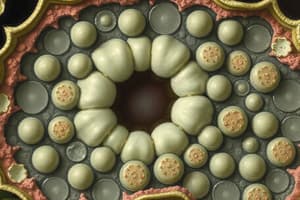Podcast
Questions and Answers
What is the primary function of connective tissue?
What is the primary function of connective tissue?
- Providing structure and support (correct)
- Generating movement
- Enabling communication and regulation
- Acting as a barrier
Which type of tissue forms the outer layer of the skin?
Which type of tissue forms the outer layer of the skin?
- Nervous tissue
- Connective tissue
- Muscle tissue
- Epithelial tissue (correct)
What role does muscle tissue play in the body?
What role does muscle tissue play in the body?
- Allowing controlled movement
- Generating movement (correct)
- Providing support
- Enabling communication
What is the main function of nervous tissue?
What is the main function of nervous tissue?
Which tissue type allows for controlled movement in the body?
Which tissue type allows for controlled movement in the body?
Which type of tissue acts as a barrier in the body?
Which type of tissue acts as a barrier in the body?
What is the function of epithelial tissue?
What is the function of epithelial tissue?
What distinguishes muscle tissue from other types of tissues?
What distinguishes muscle tissue from other types of tissues?
Which of the following is NOT a major type of tissue found in organisms?
Which of the following is NOT a major type of tissue found in organisms?
What is the key characteristic of nervous tissue?
What is the key characteristic of nervous tissue?
Flashcards are hidden until you start studying
Study Notes
Exploring the Functions and Types of Tissues in Biology
Tissues are fundamental units of life within multicellular organisms, composed of specialized cells that work together to perform specific functions. They form the foundation of our organs and organ systems, which ensure our health and survival.
The Function of Tissues
Tissues facilitate and coordinate activities essential to an organism's well-being. They:
- Provide structure and support (connective tissue)
- Act as barriers (epithelial tissue)
- Allow controlled movement (muscle tissue)
- Enable communication, regulation, and sensing (nervous tissue)
Types of Tissues
Organisms possess four major tissue types, each with specific roles:
-
Epithelial tissue covers surfaces and lines body cavities, playing a protective role and controlling the passage of molecules in and out of an organism. For example, the outer layer of your skin is made of epithelial tissue.
-
Connective tissue supports and connects other tissues. It includes loose connective tissue, dense connective tissue (e.g., tendons and ligaments), and specialized forms such as adipose tissue (body fat), bone, and cartilage.
-
Muscle tissue generates movement and maintains posture. There are three types of muscle tissue: skeletal, smooth, and cardiac.
-
Nervous tissue consists of neurons and glia that transmit and process information. Neurons generate electrical signals called nerve impulses, while glia provide support and insulation.
Tissues and Organs
Tissues combine to form organs, which carry out specific functions within organ systems. For example, the heart is an organ composed of cardiac muscle tissue and contractile proteins, which pump blood throughout the body. A single organ can contain all four primary tissue types, as the heart does with cardiac muscle, connective tissue, and epithelial tissue in its valves.
Understanding the structure and function of tissues is crucial for advancing our knowledge of biology and medicine. Researchers are developing new methods to manipulate tissues and grow artificial tissues and organ-like structures, which could lead to innovative treatments for injuries, diseases, and the replacement of damaged organs.
Studying That Suits You
Use AI to generate personalized quizzes and flashcards to suit your learning preferences.




